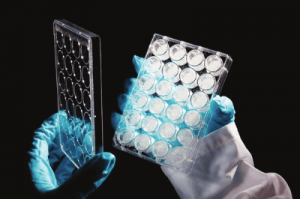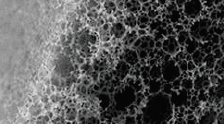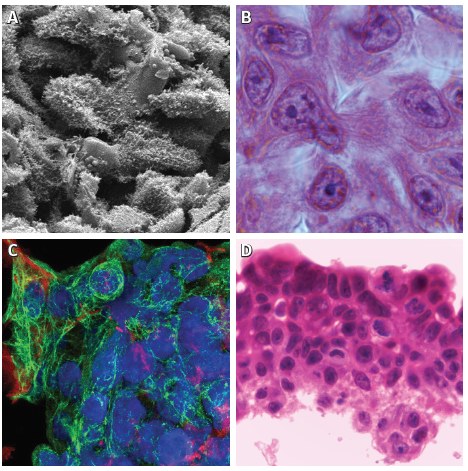Alvetex 3D cell culture systems

Alvetex® is a highly porous polystyrene scaffold designed for 3D cell culture
Achieve genuine three dimensional cell culture, simple and routinely
Cells grown in Alvetex maintain their in vivo morphology, behaviour and responsiveness within an in vitro model system. Alvetex enables cells to maintain their natural shape and to freely interact with neighbouring cells in 3D so that they function in a more physiologically relevant manner.
Presented as a 200 μm thick membrane, Alvetex has been adapted to fit a variety of conventional cell culture plasticware formats. Each product unit has been terminally sterilised by gamma irradiation and remains sterile until its blister pack is opened. Alvetex requires an ethanol wash prior to use to render it hydrophilic. Alvetex does not degrade during normal use.
Different Alvetex architectures to suit your research needs
Alvetex is now available in two types: Alvetex Scaffold and Alvetex Strata. Both materials are presented as 200 µm thick membranes of highly porous cross-linked polystyrene. The difference between them is their fine structure and architecture.
Alvetex Scaffold, is primarily designed for three dimensional culture of dissociated mammalian cells within the scaffold. Average void size: 42 µm.
Alvetex Strata, second generation product, is primarily designed to support the growth of cells and intact tissues on the surface of the membrane. Average void size: 15 µm.
Alvetex Scaffold
Alvetex Strata


Scanning electron micrographs of Alvetex Scaffold (left) and Alvetex Strata (right) in transverse section.
Alvetex enhances the biological relevance of your cell culture research
Typical mammalian cells are around 10-25 μm in size and are rarely further than 0-50 μm from another cell or 100-200 μm from a source of nutrients via a blood capillary. By recreating this complex cellular organisation and environment experienced by cells within their native tissues, Alvetex 3D cell culture enables more accurate investigation into the study of cell behaviour and function compared with conventional 2D model systems.
Cells grow and divide occupying the 3D space within Alvetex (or in many instances, on top of Alvetex Strata), maintaining their natural shape and forming complex interactions with one another in a manner that closely mimics normal growth in tissues. The cells may lay down extra-cellular matrix which often leads to the formation of “mini-slab” tissue-like structures. Alvetex is compatible with a broad range of standard molecular, cellular and histological techniques.

Examples of cells grown on Alvetex, visualised by various techniques.
(A.) Scanning Electron Micrograph of cells grown throughout Alvetex Scaffold. (B.) Murine keratinocytes grown in Alvetex Scaffold; fixed, embedded, Paraffin sectioned, stained and viewed by bright field microscopy. (C.) Hepatocarcinoma HepG2 cells grown on Alvetex Scaffold. Triple fluorescent stained and viewed by confocal microscopy. (D.) Caco-2 cells in 3D growth of on top of Alvetex Strata.
Find all Alvetex products HERE

